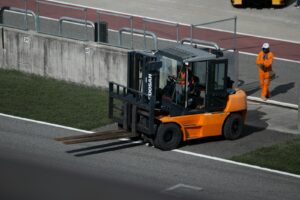Not all forklifts are built the same. Every worksite, warehouse, and yard operates in different conditions, with unique load sizes, aisle widths, and safety requirements. That’s why there are so many different types of forklifts available today, each designed to perform specific lifting and handling tasks efficiently.
Understanding the main forklift types helps businesses choose the right equipment for their needs. The right choice improves not only productivity and cost-efficiency but also workplace safety.
This guide breaks down the most common types of forklifts, what they’re used for, and how to determine which model best suits your environment.
What Is a Forklift Truck?
A forklift truck is a powered industrial vehicle designed to lift, carry, and stack materials safely over short distances. At its core, every forklift includes the same essential components: a mast (which raises and lowers the load), carriage and forks (which hold the load), a counterweight (to keep the machine stable), and a power source – usually electric, LPG, or diesel.
Forklifts are used across almost every industry, from logistics and warehousing to construction, retail, and manufacturing. Their lifting capacity can range from less than a tonne for compact indoor models to over 32 tonnes for heavy-duty industrial units.
The term forklift truck covers a wide variety of designs, and each type has its own strengths depending on the operating environment. The sections below explore the main forklift types used across Australia and how to choose the one that fits your workplace best.
6 Main Types of Forklifts
While there are dozens of forklift models on the market, most fall into seven main categories. Each type is engineered for specific applications, from moving pallets in tight warehouse aisles to lifting heavy loads outdoors on uneven terrain.
1. Counterbalance Forklift
The most common forklift type found across warehouses and loading docks. Counterbalance forklifts use a heavy rear counterweight to offset the weight of the load on the forks.
They’re fast, versatile, and available in electric, LPG, or diesel variants, making them suitable for both indoor and outdoor operations.
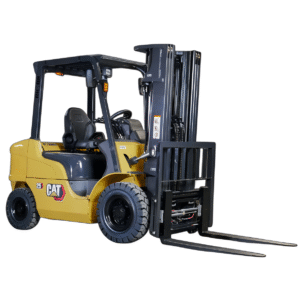
2. Reach Truck (High Reach Forklift)
Built for narrow aisles and tall racking systems, reach trucks extend their forks forward using a telescopic mast, allowing operators to place or retrieve pallets without moving the entire vehicle.
They’re ideal for high-density warehouses where vertical storage is key.
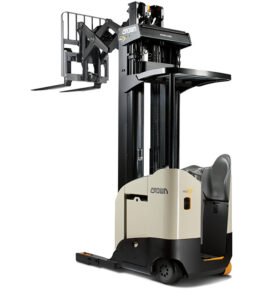
3. Walkie Stacker (Pedestrian Forklift)
Compact and easy to operate, walkie stackers are designed for light loads and small spaces.
The operator walks behind or beside the machine, steering via a tiller arm. They’re typically electric and used for tasks like restocking shelves or moving pallets within retail or storage areas.
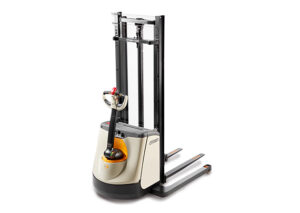
4. Rough Terrain Forklift
Rough terrain forklifts are built for construction sites, timber yards, and outdoor operations.
They feature large pneumatic tyres, powerful diesel engines, and a high ground clearance, allowing them to move heavy loads across uneven surfaces with stability and traction.

5. Pallet Jack (Pallet Truck)
Simple yet essential, pallet jacks are used for short-distance pallet movement on smooth floors.
Manual and electric versions are available, with electric pallet jacks offering effortless operation for frequent use in warehouses or retail backrooms.

6. Order Picker
Order pickers are designed for selecting individual products from shelving rather than full pallets.
The operator’s platform lifts along with the forks, allowing them to safely reach stock at different heights, common in e-commerce and inventory fulfilment centres.
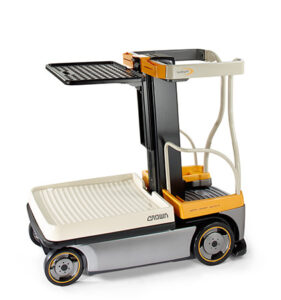
Comparing Forklift Sizes & Capacities
Forklifts come in a wide range of sizes and lifting capacities, from small walk-behind units to industrial machines capable of lifting tens of tonnes. Selecting the correct capacity is essential as an undersized forklift risks safety hazards, while an oversized one can limit manoeuvrability and efficiency.
Here’s a general overview:
- Electric warehouse forklifts: typically 1.5-3 tonnes
- LPG or diesel counterbalance forklifts: 2-5 tonnes
- Heavy-duty forklifts: 10-32 tonnes (for ports, factories, and industrial yards)
Larger models, such as a 32-tonne forklift, are engineered for high-capacity applications like container handling or manufacturing. Meanwhile, smaller electric forklifts are perfect for warehouse use where space and floor load limits matter.
Electric vs Diesel vs LPG Forklifts
The power source of a forklift significantly affects how and where it can be used. Each type has distinct benefits depending on your workplace conditions.
Electric Forklifts
- Best for indoor environments due to zero emissions and quiet operation.
- Require battery charging infrastructure, but have lower running costs over time.
- Offer smooth acceleration and excellent manoeuvrability.
Diesel Forklifts
- Provide high torque and lifting power, ideal for outdoor or heavy-duty use.
- Handle rough terrain and long operating hours efficiently.
- Produce emissions, so they’re not suited for indoor spaces without ventilation.
LPG (Gas) Forklifts
- A versatile middle ground, suitable for both indoor and outdoor use when properly ventilated.
- Quicker to refuel than electric units, making them ideal for continuous shifts.
- Slightly higher running costs but strong performance across most environments.
When choosing between them, consider air quality, noise limits, lift requirements, and running hours. Many warehouses now operate a mix of electric and LPG units to cover both indoor and yard operations effectively.
Choosing the Right Forklift for Your Business
Selecting the right forklift starts with understanding how it will be used day to day. The main factors to consider are load weight, lift height, surface type, aisle width, and operating environment.
For example:
- Warehouses and distribution centres often rely on reach trucks or counterbalance forklifts for fast pallet movement and stacking.
- Construction sites or outdoor yards typically require rough terrain forklifts with large tyres and diesel engines for stability on uneven ground.
- Retail and logistics operations benefit from compact electric pallet jacks and walkie stackers for manoeuvring stock in tight areas.
- Manufacturing or industrial sites may need side loaders or heavy-duty models for long or oversized loads.
When choosing, it’s also important to consider operator comfort, safety features, and servicing requirements. The most efficient forklift is one that balances performance with reliability and fits seamlessly into your workflow.
Maintaining & Servicing Different Forklift Types
Keeping forklifts properly maintained is essential for safety, reliability, and long-term performance. Every forklift type has its own servicing requirements, and understanding these differences helps prevent downtime and costly repairs.
Electric forklifts are generally low-maintenance but require regular checks on the battery and electrical systems. This includes monitoring charge levels, topping up battery fluids when needed, and inspecting terminals for corrosion.
Diesel forklifts, on the other hand, involve more mechanical servicing. They need routine oil and filter changes, engine tune-ups, and emissions testing to keep them running efficiently and within compliance standards. Given their use in outdoor and heavy-duty environments, they also benefit from regular inspections of tyres, brakes, and hydraulic systems.
LPG forklifts sit somewhere in between. Their engines are cleaner than diesel models but still require periodic servicing of the fuel system, including hose, regulator, and valve checks. Ensuring all components are leak-free and functioning correctly is crucial for safe operation.
Regardless of power source, all forklifts benefit from consistent preventative maintenance, checking tyres, forks, hydraulics, and braking systems on a routine schedule.
Talk With Our Team To Find Your Ideal Fit
At Freedom Forklifts, we understand that choosing the right equipment can make or break the efficiency of your operation. That’s why we take the time to understand how your business runs before recommending the right forklift for the job.
We supply a wide range of forklifts designed to handle almost any application. Our lineup includes counterbalance forklifts, high reach and reach trucks, rough terrain models, and electric pallet jacks, available for both short- and long-term hire as well as purchase options for growing fleets.
If you’d like tailored advice or a quote, get in touch with our team. We’ll help you find the best forklift for your site and make sure it keeps performing for years to come.

